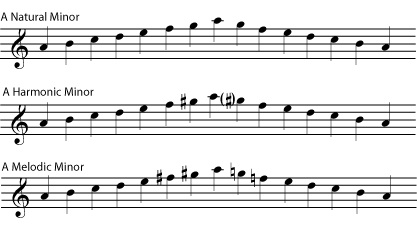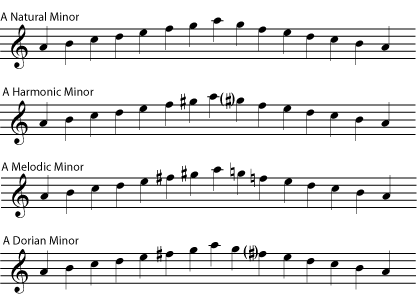| << Chapter < Page | Chapter >> Page > |

What are the relative majors of the minor keys in [link] ?
All of the scales above are natural minor scales . They contain only the notes in the minor key signature. There are two other kinds of minor scales that are commonly used, both of which include notes that are not in the key signature. The harmonic minor scale raises the seventh note of the scale by one half step, whether you are going up or down the scale . Harmonies in minor keys often use this raised seventh tone in order to make the music feel more strongly centered on the tonic . (Please see Beginning Harmonic Analysis for more about this.) In the melodic minor scale , the sixth and seventh notes of the scale are each raised by one half step when going up the scale, but return to the natural minor when going down the scale . Melodies in minor keys often use this particular pattern of accidentals , so instrumentalists find it useful to practice melodic minor scales.

Listen to the differences between the natural minor , harmonic minor , and melodic minor scales.
Rewrite each scale from [link] as an ascending harmonic minor scale.

Rewrite each scale from [link] as an ascending and descending melodic minor scale.

Major and minor scales are traditionally the basis for Western Music , but jazz theory also recognizes other scales, based on the medieval church modes , which are very useful for improvisation. One of the most useful of these is the scale based on the dorian mode, which is often called the dorian minor , since it has a basically minor sound. Like any minor scale, dorian minor may start on any note, but like dorian mode, it is often illustrated as natural notes beginning on d.

Comparing this scale to the natural minor scale makes it easy to see why the dorian mode sounds minor; only one note is different.

You may find it helpful to notice that the "relative major" of the Dorian begins one whole step lower. (So, for example, D Dorian has the same key signature as C major.) In fact, the reason that Dorian is so useful in jazz is that it is the scale used for improvising while a ii chord is being played (for example, while a d minor chord is played in the key of C major), a chord which is very common in jazz. (See Beginning Harmonic Analysis for more about how chords are classified within a key.) The student who is interested in modal jazz will eventually become acquainted with all of the modal scales . Each of these is named for the medieval church mode which has the same interval pattern, and each can be used with a different chord within the key. Dorian is included here only to explain the common jazz reference to the "dorian minor" and to give notice to students that the jazz approach to scales can be quite different from the traditional classical approach.


Notification Switch
Would you like to follow the 'Introduction to music theory' conversation and receive update notifications?